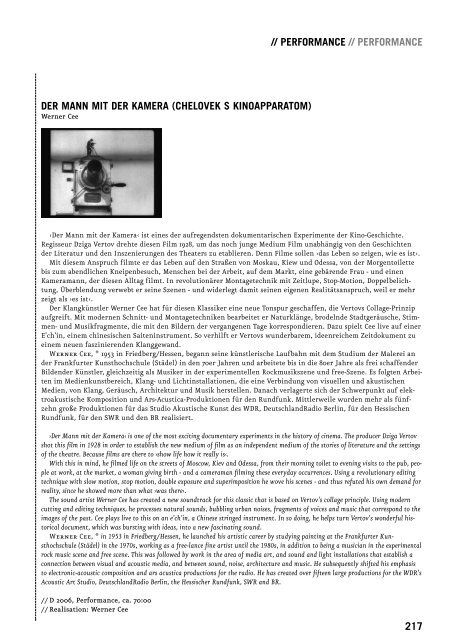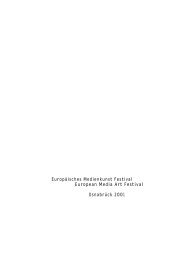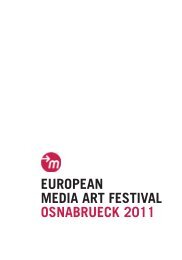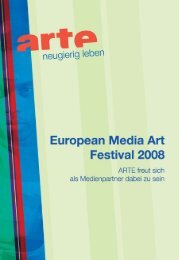Create successful ePaper yourself
Turn your PDF publications into a flip-book with our unique Google optimized e-Paper software.
PERFORMANCE // PERFORMANCE<br />
DER MANN MIT DER KAMERA (CHELOVEK S KINOAPPARATOM)<br />
Werner Cee<br />
›Der Mann mit der Kamera‹ ist eines der aufregendsten dokumentarischen Experimente der Kino-Geschichte.<br />
Regisseur Dziga Vertov drehte diesen Film 1928, um das noch junge Medium Film unabhängig von den Geschichten<br />
der Literatur und den Inszenierungen des Theaters zu etablieren. Denn Filme sollen ›das Leben so zeigen, wie es ist‹.<br />
Mit diesem Anspruch filmte er das Leben auf den Straßen von Moskau, Kiew und Odessa, von der Morgentoilette<br />
bis zum abendlichen Kneipenbesuch, Menschen bei der Arbeit, auf dem Markt, eine gebärende Frau - und einen<br />
Kameramann, der diesen Alltag filmt. In revolutionärer Montagetechnik mit Zeitlupe, Stop-Motion, Doppelbelichtung,<br />
Überblendung verwebt er seine Szenen - und widerlegt damit seinen eigenen Realitätsanspruch, weil er mehr<br />
zeigt als ›es ist‹.<br />
Der Klangkünstler Werner Cee hat für diesen Klassiker eine neue Tonspur geschaffen, die Vertovs Collage-Prinzip<br />
aufgreift. Mit modernen Schnitt- und Montagetechniken bearbeitet er Naturklänge, brodelnde Stadtgeräusche, Stimmen-<br />
und Musikfragmente, die mit den Bildern der vergangenen Tage korrespondieren. Dazu spielt Cee live auf einer<br />
E'ch'in, einem chinesischen Saiteninstrument. So verhilft er Vertovs wunderbarem, ideenreichem Zeitdokument zu<br />
einem neuen faszinierenden Klanggewand.<br />
Werner Cee, * 1953 in Friedberg/Hessen, begann seine künstlerische Laufbahn mit dem Studium der Malerei an<br />
der Frankfurter Kunsthochschule (Städel) in den 70er Jahren und arbeitete bis in die 80er Jahre als frei schaffender<br />
Bildender Künstler, gleichzeitig als Musiker in der experimentellen Rockmusikszene und free-Szene. Es folgten Arbeiten<br />
im Medienkunstbereich, Klang- und Lichtinstallationen, die eine Verbindung von visuellen und akustischen<br />
Medien, von Klang, Geräusch, Architektur und Musik herstellen. Danach verlagerte sich der Schwerpunkt auf elektroakustische<br />
Komposition und Ars-Acustica-Produktionen für den Rundfunk. Mittlerweile wurden mehr als fünfzehn<br />
große Produktionen für das Studio Akustische Kunst des WDR, DeutschlandRadio Berlin, für den Hessischen<br />
Rundfunk, für den SWR und den BR realisiert.<br />
›Der Mann mit der Kamera‹ is one of the most exciting documentary experiments in the history of cinema. The producer Dziga Vertov<br />
shot this film in 1928 in order to establish the new medium of film as an independent medium of the stories of literature and the settings<br />
of the theatre. Because films are there to ›show life how it really is‹.<br />
With this in mind, he filmed life on the streets of Moscow, Kiev and Odessa, from their morning toilet to evening visits to the pub, people<br />
at work, at the market, a woman giving birth - and a cameraman filming these everyday occurrences. Using a revolutionary editing<br />
technique with slow motion, stop motion, double exposure and superimposition he wove his scenes - and thus refuted his own demand for<br />
reality, since he showed more than what ›was there‹.<br />
The sound artist Werner Cee has created a new soundtrack for this classic that is based on Vertov's collage principle. Using modern<br />
cutting and editing techniques, he processes natural sounds, bubbling urban noises, fragments of voices and music that correspond to the<br />
images of the past. Cee plays live to this on an e'ch'in, a Chinese stringed instrument. In so doing, he helps turn Vertov's wonderful historical<br />
document, which was bursting with ideas, into a new fascinating sound.<br />
Werner Cee, * in 1953 in Friedberg/Hessen, he launched his artistic career by studying painting at the Frankfurter Kunsthochschule<br />
(Städel) in the 1970s, working as a free-lance fine artist until the 1980s, in addition to being a musician in the experimental<br />
rock music scene and free scene. This was followed by work in the area of media art, and sound and light installations that establish a<br />
connection between visual and acoustic media, and between sound, noise, architecture and music. He subsequently shifted his emphasis<br />
to electronic-acoustic composition and ars acustica productions for the radio. He has created over fifteen large productions for the WDR's<br />
Acoustic Art Studio, DeutschlandRadio Berlin, the Hessischer Rundfunk, SWR and BR.<br />
// D 2006, Performance, ca. 70:00<br />
// Realisation: Werner Cee<br />
217












